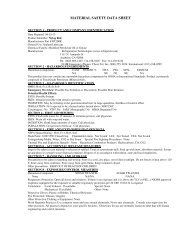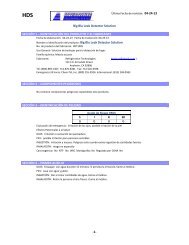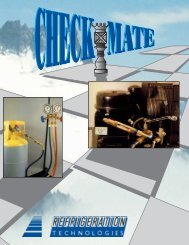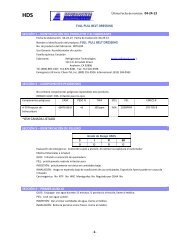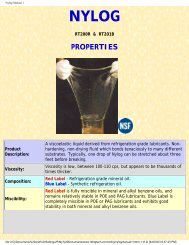Balancing of a Water and Air System (PDF
Balancing of a Water and Air System (PDF
Balancing of a Water and Air System (PDF
Create successful ePaper yourself
Turn your PDF publications into a flip-book with our unique Google optimized e-Paper software.
110<br />
Cold-water temperatures should not be taken in the tower basin or by bleeding water<br />
from the basin or outlet pipe since temperature gradients <strong>of</strong> several degrees may exist in<br />
the basin <strong>and</strong> the suction piping extending from the tower to the pump. Only after the<br />
water is well-mixed by the pump can one be assured the measured temperature is<br />
representative <strong>of</strong> the true cold water temperature leaving the tower.<br />
Many cooling tower systems have an automatic or manual bypass arrangement (Figure<br />
13.4) used to control temperatures in the cooling loop by diverting hot water from the<br />
cooling tower riser into the cold water line leaving the tower or into the tower basin.<br />
Where such a bypass line exists, it is imperative it be shut<br />
The cold-water temperatures should be measured on the discharge side <strong>of</strong> the system<br />
circulating pump (Figures 13.1 8z 13.2). If the temperature <strong>of</strong> the cold water leaving the<br />
pump is being measured through a bleed test valve (as shown in Figure 13.3), the<br />
average temperature must be corrected for the heat added by the pump <strong>and</strong> the valve.<br />
The test valve must be sufficiently opened to provide adequate quantities to establish<br />
accurate temperature measurements. Cold-water temperatures should not be taken in the<br />
tower basin or by bleeding water from the basin or outlet pipe since temperature<br />
gradients <strong>of</strong> several degrees may exist in the basin <strong>and</strong> the suction piping extending<br />
from the tower to the pump. Only after the water is well-mixed by the pump can one be<br />
assured the measured temperature is representative <strong>of</strong> the true cold water temperature<br />
leaving the tower.<br />
Many cooling tower systems have an automatic or manual bypass arrangement (Figure<br />
13.4) used to control temperatures in the cooling loop by diverting hot water from the<br />
cooling tower riser into the cold water line leaving the tower or into the tower basin.<br />
Where such a bypass line exists, it is imperative it be shut with a liquid <strong>of</strong> high thermal<br />
conductivity (oil or water).<br />
Inlet <strong>Air</strong> Temperature Measurements<br />
The wet bulb temperature <strong>of</strong> the air entering the cooling tower is a required measurement<br />
on all tests. Similarly, the dry bulb temperature <strong>of</strong> the entering air stream is required on<br />
forced draft (blow through) towers to determine the density <strong>of</strong> the air entering the fan(s).<br />
Wet bulb temperature must be measured with mechanically aspirated psychrometer.<br />
Mount the psychrometer on tripods or other support devices so they remain stationary<br />
for the duration <strong>of</strong> the test. A sufficient number <strong>of</strong> instruments, located within four feet <strong>of</strong><br />
the cooling tower air inlet(s), shall be employed to ensure that the test average is an<br />
accurate representation <strong>of</strong> the true average inlet wet bulb temperature. See Figures 13.5<br />
<strong>and</strong> 13.6 for typical situations.<br />
110




